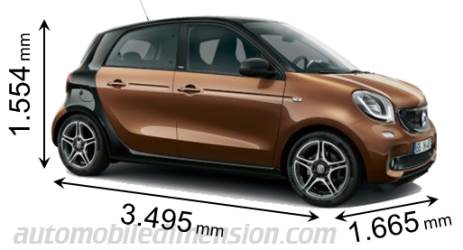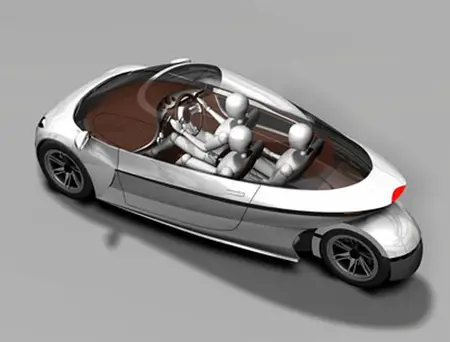 Mitsubishi's MiEV electric car provides interesting comparison material. With its Japanese K car class outer dimensions, it features a pretty standard 3.475 m. length for a city car, at 1.61 m. it's pretty high though, particularly considering its 1.475 m. width. Wheelbase 2.55 m.
Mitsubishi's MiEV electric car provides interesting comparison material. With its Japanese K car class outer dimensions, it features a pretty standard 3.475 m. length for a city car, at 1.61 m. it's pretty high though, particularly considering its 1.475 m. width. Wheelbase 2.55 m. MiEV's 4-passenger capacity sounds nice, but its rear seats practically form the car's rear crumple zone . Its 0.35 drag coefficient shows that a hatched back is not conducive to a good streamline. The same applies to the 19 cm wider Smart ForFour
MiEV's 4-passenger capacity sounds nice, but its rear seats practically form the car's rear crumple zone . Its 0.35 drag coefficient shows that a hatched back is not conducive to a good streamline. The same applies to the 19 cm wider Smart ForFourthat you see here on the left. *

With approx. 3.80 m. 'ForThree' is lengthier, and at 1.45 m. it's lower. This means passengers can recline, with legroom to spare. Its specific width of around 1.50 m. plus the seats' inward positioning (you don't sit next to each other) yield vastly better side-impact protection.
The ForThree's length is put to good use. By pushing the front-wheels forward and have the rear-wheel(s) assembly (with separately attached bumper) actually stick out, an approx. 2.75 m. long wheelbase is created. This creates great comfort, exceptional rear-impact protection, as well as enables a distinctive 0.19
lowdrag shape that tapers toward the rear to optimize visibility .

The ForFour weighs 940 kg. MiEV's weight is 1,100 kg, 200 kg of which is batteries. Plan is to have an EV version of the ForThree limit weight to 650 kg , 150-200 kg on batteries excluded. Realistic? Author thinks so. Toyota's tilting i-Road weighs 300 kg, including batteries, three-wheel suspension and tilt hardware.
A pod-like shape is inherently more rigid than a box shape (reason why tunnels and airplanes are built cylindrical). This means that lighter materials can be used. Combined with the low-drag * body, the yield is unparalleled energy efficiency, regardless of the propulsion type. Author's personal preference is either a small, latest-generation three-cylinder ICE, or electric drive (no hybrid). More on the ForThree's party piece -the ability to lean into the corner- click here .
China could surpass Germany and Italy as the largest market for Smart cars, according to Smart CEO Annette Winkler. She said that initially there were doubts about Smart becoming successful since the Chinese love for big cars. Think what this three-seater can do in this country known for its one-child family policy, cramped infrastructure and poor air quality in cities. With its Mini, BMW proved that small needn't be cheap. If it is distinctive enough, it may well be premium...For more info, contact Ralph Panhuyzen at sevehicle@gmail.com
* Measurements
Drag coefficient Smart ForFour: 0.35. Frontal area 2.22 m2. Means that total drag is 0.78 m2
Wheelbase 2.494 m. HxW : Cd = 7.39 and HxW: area = 1.16
Drag coefficient Volkswagen XL1: 0.186. Frontal area 1.50 m2. Means that total drag is 0.28 m2
Height 1.184 m. / Width 1.682 m. / Length 3.970 m. / Wheelbase 2.223 m. / Weight 800 kg, of which 105 kg is for the electrics and 227 kg for the hybrid drive (that's approx. 150 kg heavier than a small ICE).
HxW : Cd = 10.71 and HxW : area = 1.33
Based on aspect ratio's of the ForFour and VW XL1, estimates are that ForThree's drag coefficient can/will be around 0.19. Frontal area of approx. 1.72 m2. Means that total drag is 0.33 m2. Perhaps lower because of its teardrop shape - making it around 2.5 times more slippery than the ForFour. Yield is around 0.22 mpg per 0.01 improvement, which comes down to 1.5 km extra per liter for the ForThree compared to the ForFour that does around 20 km to the liter. A Ricardo survey conducted for the Aluminum Association shows that weight is actually a much more defining factor in energy economy. Think of 15% gain for a vehicle that weighs 20% less. Weighing 30% less than the Smart ForFour, the ForThree's savings must be substantial. A preliminary assessment at Tata Steel came to a very conservative estimate of 1400 lbs (approx. 650 kg) based on the use of (high-strength) steel. Use of other materials, such as aluminum, composites and thermoplastics, can further reduce the net weight.
HxW : Cd = 11.45 and HxW : area = 1.26
Obviously, still work needs to be done to the rear, although integrating the rear wheel(s) into the body will make it look silly. Also the outside mirrors can be removed.
'ForThree' in a nutshell:
* more fun to drive
* more fun to drive
* more comfortable
* safer
* more economic
* better suited to self-driving
* reduces impact of car use on our living environment
* reduces impact of car use on our living environment
* car-shared, it complements / rivals public transport
Automotive experts already acknowledged the 'outside the (car) box' vehicle described/depicted here as a viable alternative, and doable to engineer. Auctor intellectualis (and IP holder) Ralph Panhuyzen was involved with the scientific study on car mobility (ISBN-13: 978-90-442-0015-7) in the Netherlands (one of the most densely populated countries in the world) which was held under the auspices of the NWO, the Netherlands Organization for Scientific Research. NB: this presentation is put together for assessment and publicity purposes only. Unauthorized use forbidden. The New Isetta aka Smart ForThree is not an open source project, and formally OHIM registered. If in doubt about the semantics of what is "authorized" (literally: of, by or from the author) and what is not (presenting or using what has been created by someone else as if it were yours) consult a legal expert. Plagiarism is a sensitive subject in Germany in particular.
~

No comments:
Post a Comment